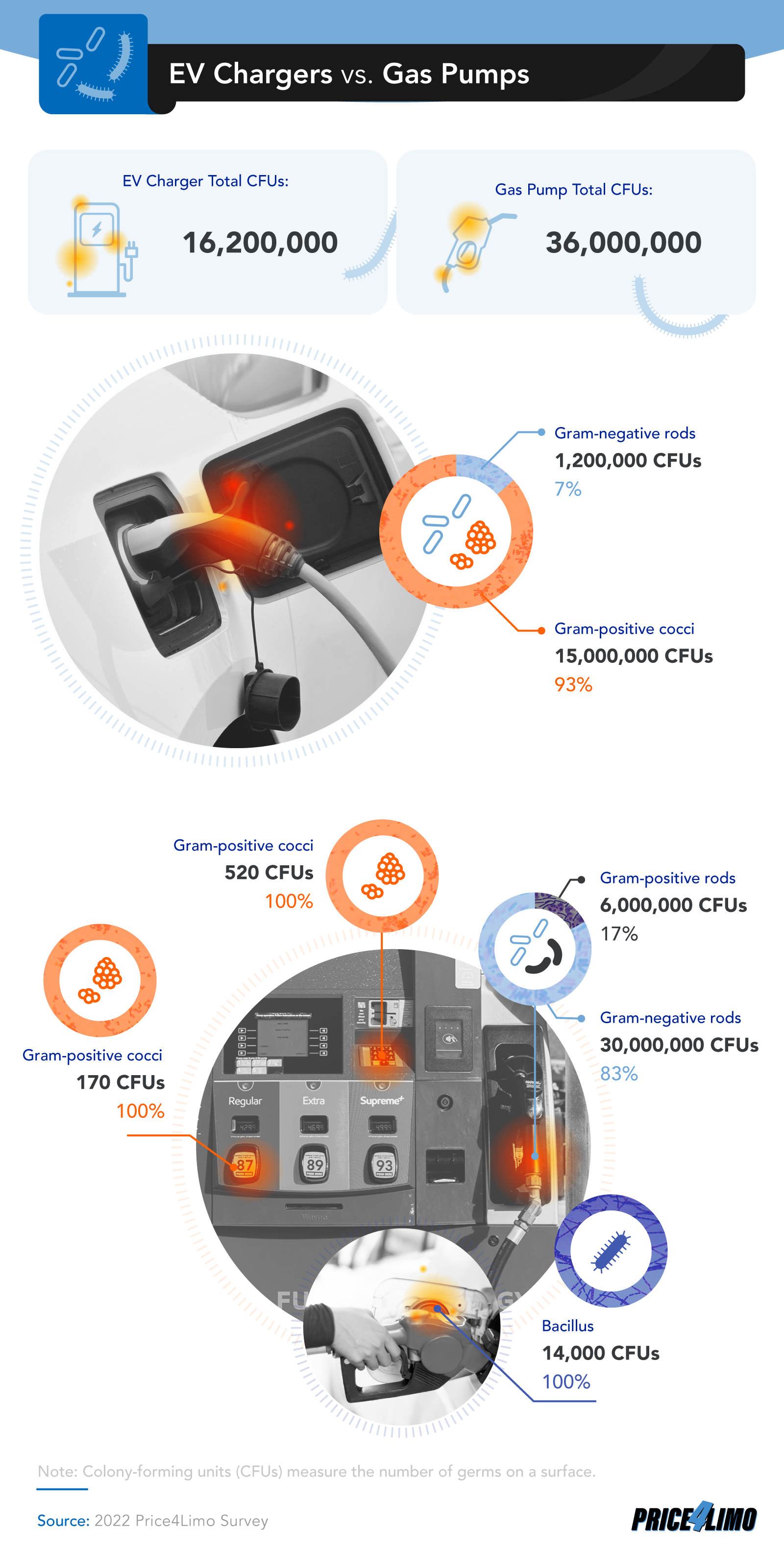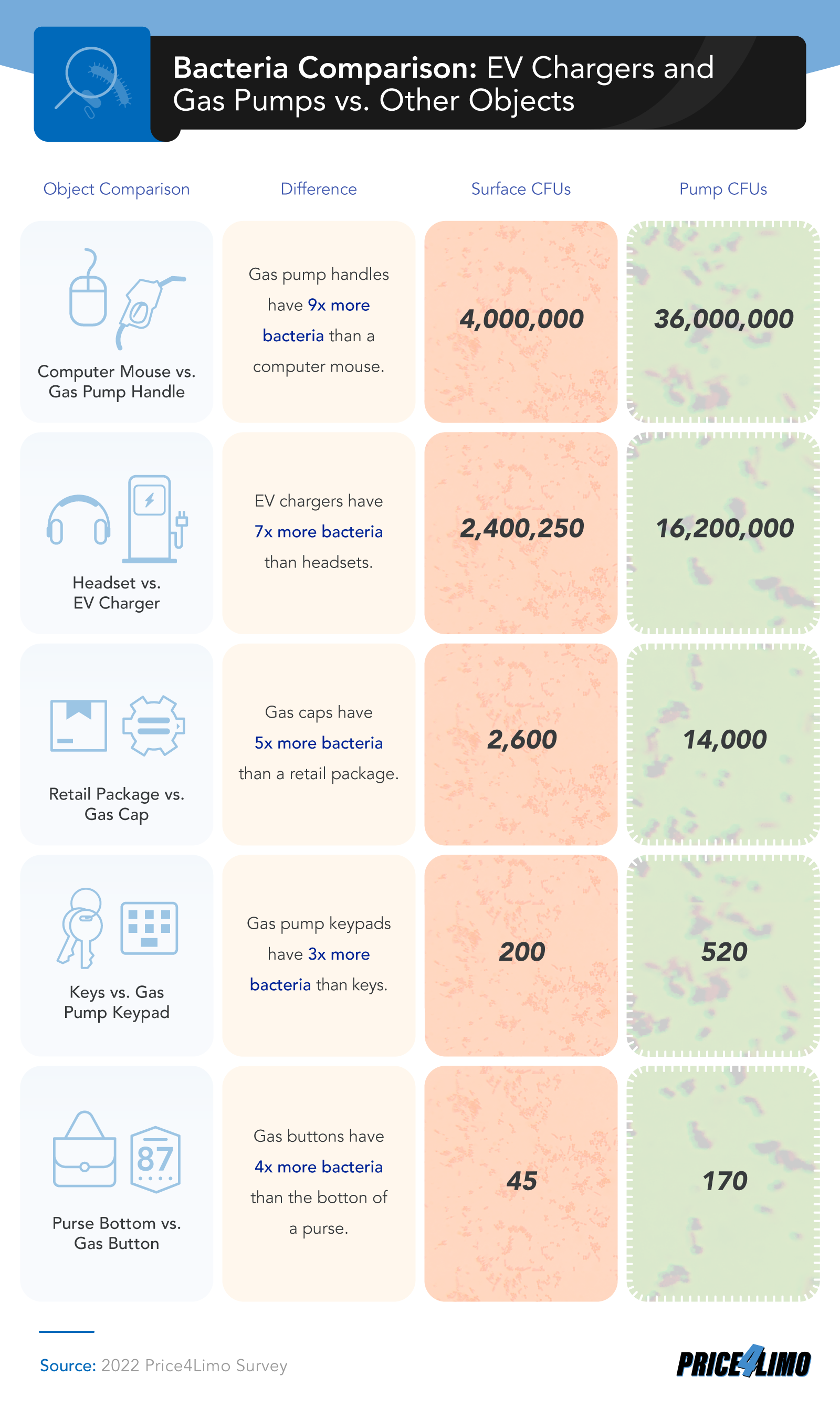What’s on Your Pump?
Some people don’t expect that one of the dirtiest places at the gas station isn’t the bathroom — it’s the pump. As electric vehicles (EVs) become more mainstream, the number of charging stations in the U.S. are increasing. The air is likely cleaner as more EVs replace gas cars, but what about the chargers you plug into when you’re out and about?
In this study, we conducted five Gram stain culture swab tests across different components of a gas pump and an EV charging station. We swabbed each surface three times and averaged the colony-forming units (CFUs) per swab for each surface type. We also compared these bacterial readings to everyday objects. What germs might you encounter the next time you’re at the pump? Read on to find out!
Key Takeaways
- EV chargers contain half the bacteria of gas pumps.
- A gas pump handle has 9x more bacteria than a computer mouse.
- An EV charger has 7x more bacteria than a headset.
Sanitization Levels at the Pump
Any shared public object will become dirty, especially high-touch surfaces like EV chargers and gas pumps. People use them daily, and who knows how often they’re cleaned (if ever). Let’s see how many germs are on each; the higher the CFU, the more germs were found, and the higher chance that you’ll get sick.

You have to touch many surfaces when you pump your own gas (unless you live in Oregon or New Jersey, where they pump it for you). Our study shows that gas pumps have a much larger amount of bacteria than their EV counterparts: 36 million vs. 16.2 million CFUs, to be exact. It may surprise you that the gas station toilet might not be the dirtiest surface you connect with during your stop. It’s important to continue washing and sanitizing your hands regularly as we transition into a post-pandemic world.
Gram-positive bacteria are generally thought of as “good” bacteria, while gram-negative bacteria are harmful. Compared to traditional gas pumps, EV chargers had less than half as much total bacteria. A pump handle alone had 30 million gram-negative rods, while the charging station had just 1.2 million. EV chargers have fewer contact points than gas pumps, making for far fewer bacterial transfers and CFUs.
Fueling Your Perspective
Next, we wanted to compare our germ numbers to everyday objects that you might come into contact with normally, like a computer mouse, headset, or car keys. Do you think they’ll have comparable levels of bacteria on them?

Bacteria levels on personal household items were much lower than those of public-use gas pumps. A pump handle had nine times more germs than a computer mouse, 36 million versus 4 million CFUs. This finding trumps EV’s highest discrepancy: An EV charger had seven times the level of bacteria as a personal headset. Gas caps versus retail packages showed the next largest difference, with caps having five times more germs.
We also found that gas station equipment had far more bacteria than smaller or less frequently touched items. The average set of keys had three times fewer germs than gas pump keypads. The bottom of a purse, known for how germy it can get, turned out to be much cleaner at 45 CFUs. On the other hand, a gas selection button had four times more bacteria than a purse bottom.
Minimizing Bacterial Traffic
Coming into contact with bacteria is inevitable in our daily lives, but we also understand the issues germ transfer can cause. The global pandemic has changed the numerous ways we work, live, and interact in our communities. Learning how to minimize germ exposure creates a cleaner world for everyone and healthier life for you and your family.
The world now knows that hand-washing is one of the best ways to keep ourselves germ-free and healthy. Now, especially with the COVID-19 pandemic finally starting to pass, staying vigilant in cleaning and disinfecting ourselves and the surfaces we come in contact with is more important than ever. EV charging is a step in the right direction, minimizing public points of contact and staying in line with the idea of clean technology.
No one is expected to wear latex gloves and an N95 mask everywhere, but some key habits are helpful to form. Firstly, understanding what you can do in your home is important — those gas pump germs came from somewhere! Keeping in mind the difference between removing germs and disinfecting them can assist in maintaining a healthy lifestyle. Buying an electric vehicle is another way to keep the environment and yourself a little more germ and pollution free.
Pulling Away With Perspective
With EV chargers seeing more and more usage, it’s good to see they trend toward being less of a bridge for public germs to travel. We found the handles had many times fewer bacteria than traditional gas pumps, even when not considering the numerous other contact points at the gas station.
Electric vehicles held up their end of the bargain when it came to a healthier world, both in emissions and bacteria transfer at the pump. The best way to take advantage of those benefits is to keep ourselves vigilant in understanding how germy our daily lives can be and disinfecting what we can.
Methodology
We conducted five total Gram stain culture swab tests across different components of a gas pump and EV charging station, swabbing each surface three times. Colony-forming units per swab were averaged for each surface type. It’s possible that we could have gained more insight into CFU levels with a larger sample size of surfaces. No statistical testing was performed, and the claims listed above are based on means alone. As such, this content is exploratory.
About Price 4 Limo
Whether you’re looking for a limousine, party bus, charter bus, or another form of transportation, Price4Limo provides what you want at a great price. We offer personalized service and over 20 years of experience.
Fair Use Statement
Do you want to share this information with someone you know? Anyone can share this article for noncommercial purposes as long as they provide a link back to this page.
